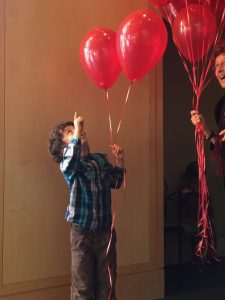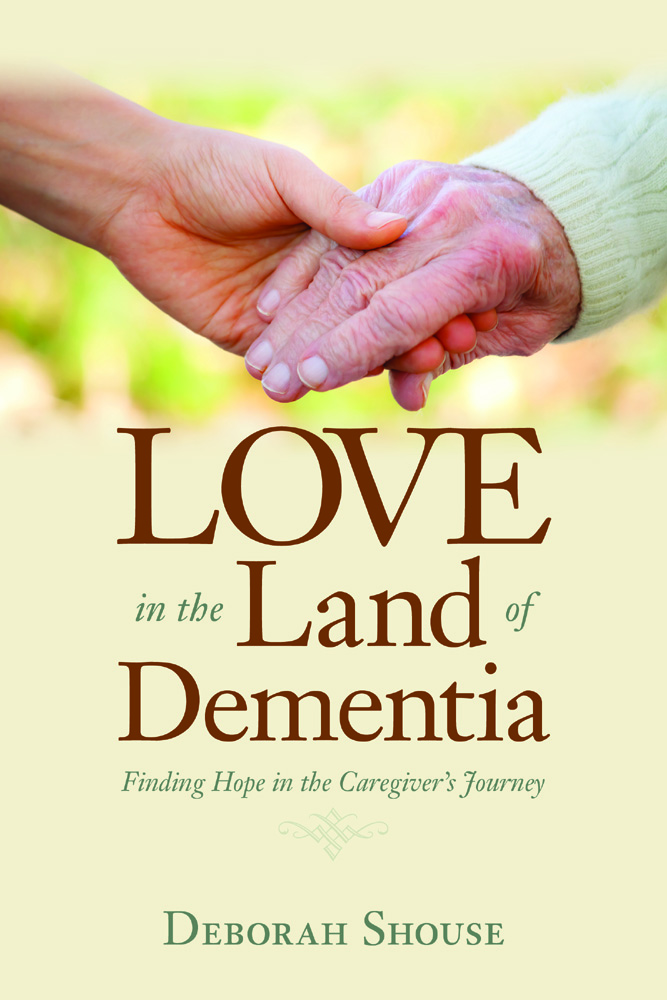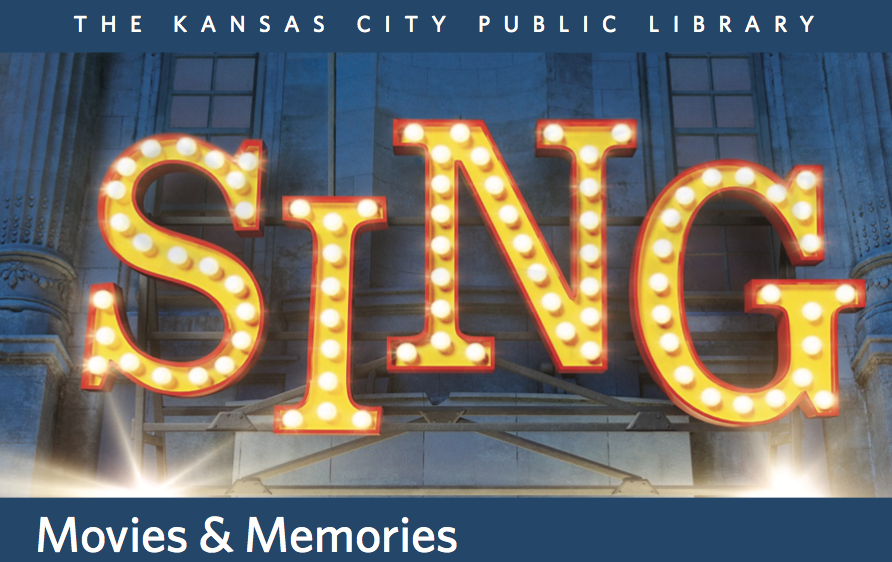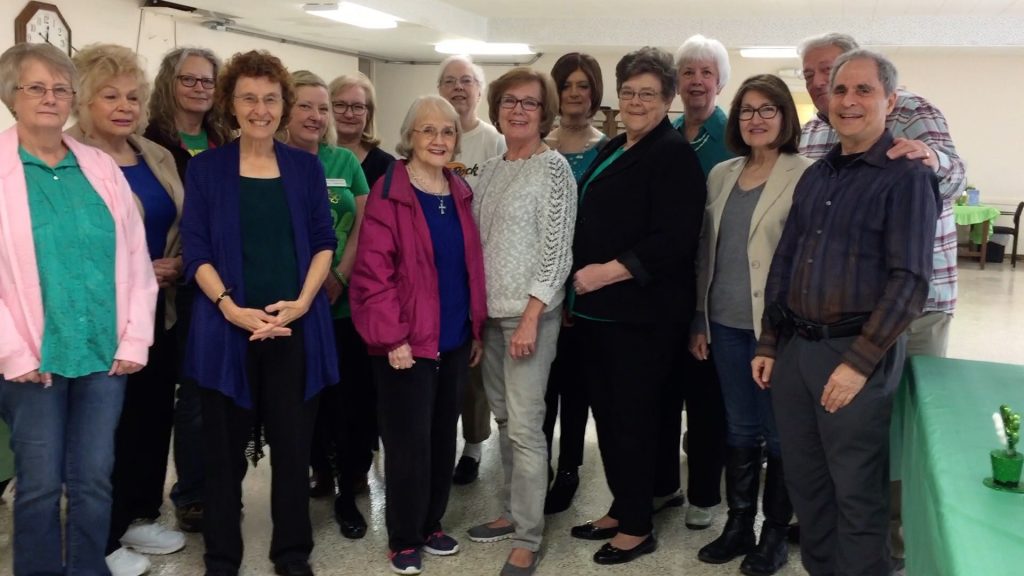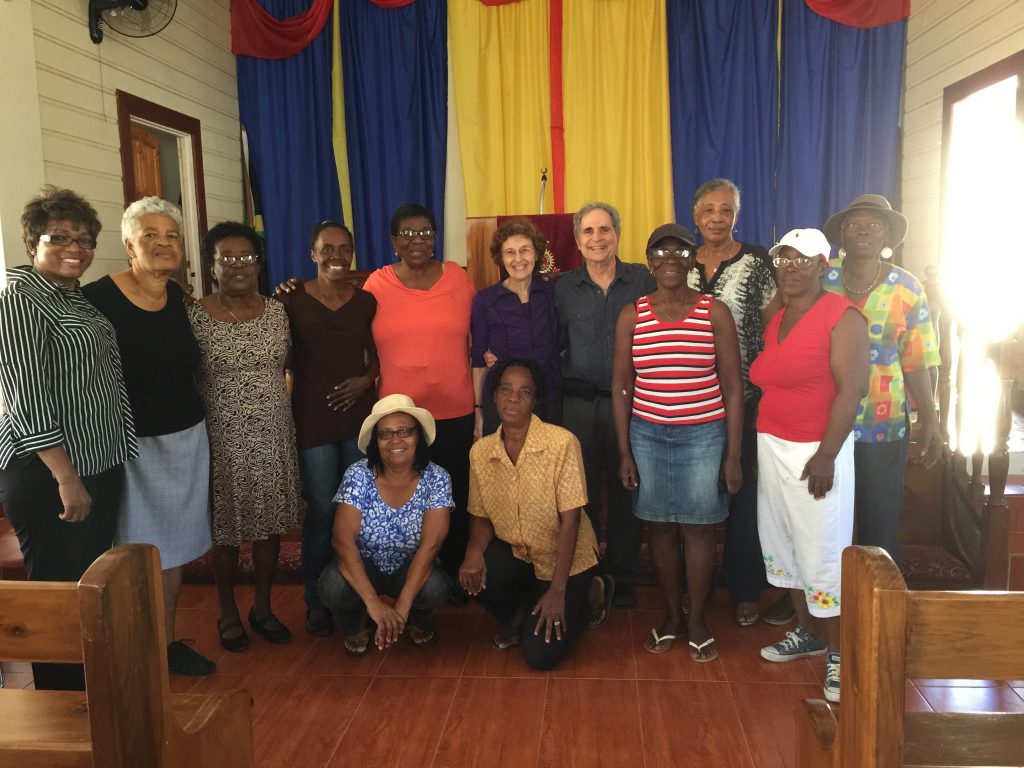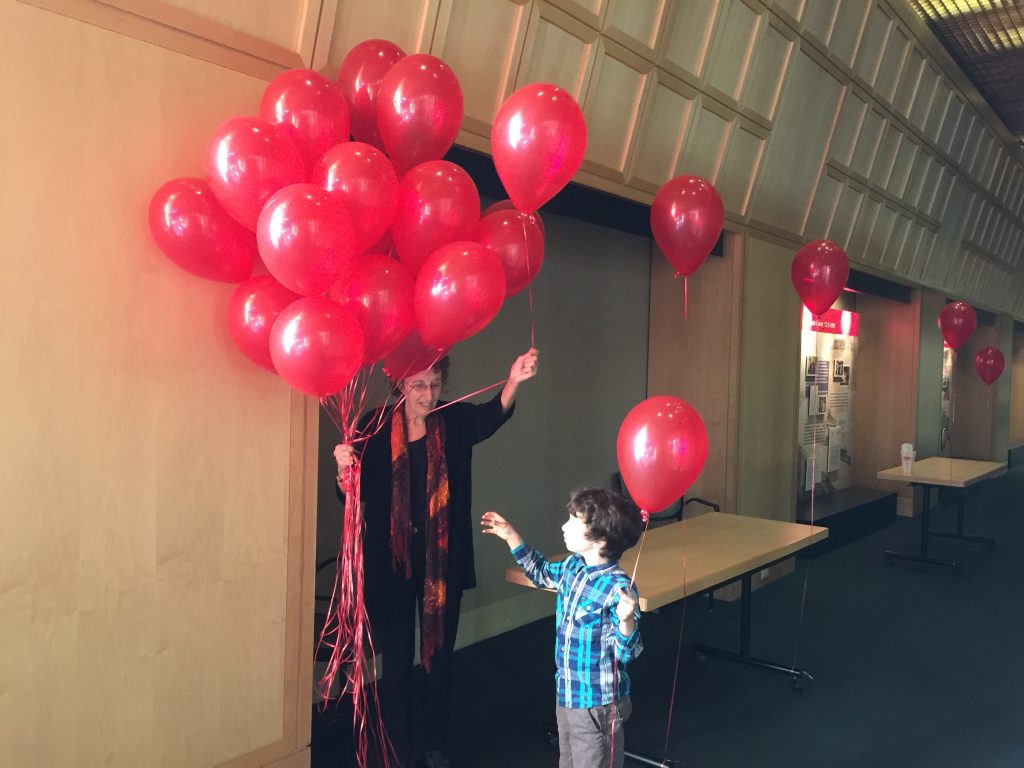The Arts
Let’s Go to the Movies: A Dementia-Friendly Series
“Let’s go to the movies,” my dad often said to my mom. My parents would have loved our Movies and Memories series, now starting its second year. We are excited to announce our partnership with the Kansas City Boys Choir and the Kansas City Girls Choir this season. Some of their outstanding performers will be joining us at each event.
Already, the series is making a difference in a variety of ways. Additional libraries in Missouri and other states are interested in implementing the program. And our library is so committed to becoming more dementia-friendly that it is having special training for its staff, courtesy of the Alzheimer’s Association — Heart of America Chapter. Please share this invitation with those who would enjoy it. And if you’re in the Kansas City area, please join us. It’s free and open to all. Let’s go to this movie series!
Art as a Creativity Catalyst: Featuring Grace and Spencer Townley-Lott

How do we keep our sense of connection and creativity through the caregiving journey? That was a question I often asked myself. I wanted to share this story of an extraordinary couple– artist, dementia advocate, and social worker Grace Townley-Lott and her husband, puppeteer, actor, and playwright, Spencer Townley-Lott. Both use art as a creativity catalyst in their work and throughout their lives.
Their elders inspired them. Grace and Spencer were teenagers when her grandmother and his great-grandmotherwere going through a dementia journey. The experience was difficult and impactful.
Grace became a social worker, specializing in older adults and learning how to communicate with people who were living with dementia, often through art.
“It’s incredible how the arts open people up,” Grace says. “Someone who hasn’t painted in 20 years picks up a brush and creates something beautiful. Someone who hasn’t spoken in ages delivers a zinger of a one-liner. Every day, I see how creative people are and the connections that are still possible.”
As Grace unfurled her work experiences, Spencer gained a new understanding of his great-grandmother’s last years. He used those insights to create a critically acclaimed play, Blossom. This play, which utilizes puppets, was funded by a Jim Henson Foundation Grant. It focuses on James Blossom, a retired painter who is living with dementia and his family’s changing relationships.
Caregivers often wonder: “How do we keep creativity alive?” Grace and Spencer were kind enough to share some ideas.
Engaging in New Endeavors: Grace
Try to be in the moment, despite your list of tasks. Respond to and validate emotions. Be willing to go with the flow so you can allow creative sparks.
Pay attention to facial expressions as you invite your loved one to engage. If you start dancing, do their eyes light up and do they laugh? If you offer watercolors and cue your partner to touch the brush to wet paper, does he respond with joy when the color blooms on the page? If you’re having a hard time getting your partner to take a shower, croon a song and waltz with him into the shower. If it doesn’t work, that’s okay, too! But if it does work, it’s a lovely and practical way to connect, create, and take care of physical needs as well.
Sometimes it takes reframing the situation to view the possibilities. An outside person or idea can often expand your thinking.
Creativity Tips for the Care Partner: Spencer
Sometimes, physical actions can help release tension to allow for more creative thinking. Deep breaths and stretching can help you loosen up at first. In the theater world, we start every rehearsal with a physical game or action to help us get focused and leave our stress at the door. Try wiggling and shaking your feet and hands, giving yourself a brief facial massage, stretching as tall as you can, and twisting gently left and right. You’re getting the blood flowing, leaving the worried part of you in the hallway, and getting ready to create.
Allow room for surprises. Try to set the tone by modeling joy and openness. Be willing to try again.
Connecting through Art: Grace
I love viewing art with people who have dementia. Art is so subjective, so there’s no wrong answer to the question, “What do you see?” You can take that first question and lead it along into a fascinating conversation, one question at a time, building a fulfilling conversation with an individual or a group.
In these art viewings, a discussion about a painting can tap into emotions that would otherwise be left undiscussed, or it could lead into a beautiful conversation about the person’s childhood, for example. You never know where the conversation will lead! This creates a failure-free situation where a person with dementia can excel and their answers are valued.
Connecting through Puppets: Spencer
Puppets offer a level of separation for the care partner. For people living with dementia, a puppet’s cues may be simpler to decode, dramatically expressing joy or sorrow. The puppet can place a hand on a shoulder and offer many opportunities for sensory engagement.
Puppets can also encourage intergenerational play, creating connections between family members who may be unsure who to communicate with their loved one with dementia.
Keeping Your Creative Flow: Spencer and Grace
“Creativity is inherent in all of us,” Spencer says. “It’s a muscle you can strengthen. Be patient with yourself. The first day, you can only do one push-up. The second day, you can accomplish two or three. That’s what creativity and artistry feels like. Start small. You are laying the foundation. And it gets easier.”
“Be present and be ready for anything,” Grace says. “By asking your loved ones for advice, truly listening to them, and just being with them, you can form beautiful interactions throughout life.”
To learn more about Spencer, visit
To learn more about Grace, visit
gracetownley.com and theartfuloven.com
Grace is the Director of Truly Inspired Outreach and Education for True Care Home Health.
Deborah Shouse is the author of Connecting in the Land of Dementia: Creative Activities to Explore Together and Love in the Land of Dementia: Finding Hope in the Caregiver’s Journey.
Embracing Person-Centered Dementia Values: The Dementia Action Alliance
One by one, we say hello via video conferencing. We are writers, artists, and arts advocates from all over the country. One sculptor enriches the visual aspects of our meeting by strolling through a museum, giving us occasional glimpses of vibrant art. We meet another artist’s dog. Via video, we see each other’s offices and learn each other’s names and goals. Some of the participants are living with dementia; some are not. All of us are brainstorming ways to use the arts as a catalyst to connect people. Already it is working: through the Dementia Action Alliance, our arts group is already engaging in deep and honest conversation, discussing ways to weave creativity and the arts through June’s conference in Atlanta, and exploring ways we can help others stay connected through the arts.
I have long admired the Dementia Action Alliance and feel honored to be part of their creative process. Their “Person-Centered Dementia Values and Principles” were inspired by the Pioneer Network and have been customized by people living with dementia. Karen Love, Executive Director of DAA, tells us, “Because people who have dementia are the experts, the values are written from their perspective in first person narrative. This orientation helps us focus on what is important.”
Here are some of their core ideas:
Person-Centered Dementia Values and Principles
• I am a person living with dementia. Spend time getting to know me and relating to me as a person with a unique background, life history, interests and capabilities.
• Help me stay connected to what is important to me. Although aspects of my personhood may become increasingly hidden, I am still here.
• A reciprocal relationship is important to me. Autonomy, choices, dignity, privacy, self-determination are fundamental to my well-being.
• Support my holistic emotional, social, physical, cultural, sexual, and spiritual dimensions.
• Promote my personal growth and development. Help me continue to experience purpose, meaning, relationships and enjoyment in my daily life.
• Partner with me, utilize my strengths, and provide the right amount of support and opportunities I need to achieve my goals.
• Some dementia symptoms may interfere with my communication. I communicate the best I can; assume positive intent. Attempt to understand my needs and my reality. Please be compassionate.
For me, reading these principles reminds me how much we are all alike.
For more information on this topic and to learn about the DAA’s upcoming conference:
Conference: Re-Imagine Life with Dementia
You’ll enjoy reading this white paper on Living with Dementia: Changing the Status Quo, DAA
Deborah Shouse is the author of Connecting in the Land of Dementia: Creative Activities to Explore Together and Love in the Land of Dementia: Finding Hope in the Caregiver’s Journey.
Sharing Ideas for Staying Connected
“How do we stay connected during the dementia journey?” This is a question with dozens of creative answers. Recently, we spent time at Northland Shepherd Center, hosted by Dianna Englander. We were sharing ideas for staying connected with the Together We Care Caregiver Support Group, a lovely gathering of family caregivers and friends. 
Caregiving is such a creative practice, demanding flexibility, humor, and the willingness to make mistakes and try again. We discussed ideas from Connecting in the Land of Dementia, including incorporating singing, laughter, and art into everyday life. We also explored the power of nature and talked about unique concepts for bringing the outdoors inside. We brainstormed different ways we could prepare food together and connect in the kitchen.
Here are some extra ideas we learned from our audience. I’ve changed the names to protect people’s privacy.
Anne’s father, who was normally very active, became very upset when his care facility had to temporarily curtail his movements, due to a flu outbreak.
“I want to go to the hospital,” he told the care staff repeatedly. Finally, they called Anne and asked her to come over.
“Dad was just wild,” she told us. “So I asked him to take a deep breath with me, and told him we were going to watch a basketball game before we problem-solved.” They watched an hour of basketball, which soothed both of them.
“I want to go to the hospital,” her father said.
“Why?” she asked.
“So I won’t feel alone,” he said. “I’m scared to be alone.”
Anne realized how social her father was, always walking down the hallways, greeting people, spending time visiting. She instantly began to problem solve, getting permission to walk down the corridors, wearing protective masks, gathering phone numbers of her father’s friends at the home, so he could call them.
“Taking a break and doing something soothing first really helped us figure out the problem and then solve it,” she said.
…………………….
Before her dementia advanced, Sandra’s friend loved singing in the church choir. Now, when Sandra visits her, her friend frequently asked the same question over and over. Sandra turns to beloved hymns they both know so well and when her friend becomes anxious, starts singing to change the energy. Soon, they are both singing, as they have for so many years, the old hymns guiding them back to a deep connection.
…………………….
Patriotic songs inspired Alvin’s father, Fred. So often, Fred literally tuned out the singers who came to entertain at his memory care community. One day, the group began singing “The Star Spangled Banner,” Instantly, Fred stood and put his hand over his heart. He sang along and kept standing and singing through all the familiar patriotic melodies. Afterwards, he talked about his time in the service, breaking his usual stoic silence.
At the end, we all felt a sense of renewal and companionship. Sharing these important creative ideas had enriched our lives and inspired us anew.
I’d love to hear your ideas for staying connected. Please email me at myinfo@pobox.com.
For more information about the Northland Shepherd Center, visit http://northlandsc.org/about-nsc.html
Deborah Shouse is the author of Connecting in the Land of Dementia: Creative Activities to Explore Together and Love in the Land of Dementia: Finding Hope in the Caregiver’s Journey.
Insider’s Tips for Analyzing Activities Programs
My mother had been an artist in her later years, but she stopped painting when she began living with memory loss. Instead, she took comfort in listening to music and in nurturing a baby doll. Ron’s dad studied architecture as a young man, but never had the leisure time to pursue drawing or art. When he moved into a memory care community, he flourished in the Memories in the Making painting program. We worked hard to find care homes that nurtured our parents and my background in healthcare helped us develop a few insider’s tips for analyzing activities programs.
“Families need to share information about favorite hobbies and they also need to be ready for their loved one to try new things and possibly change interests,” says Alisa Tagg, President of the National Association of Activity Professionals. Alisa has helped dozens of facilities build meaningful activity programs.
Here’s an example of how one woman thrived on learning a new skill and giving back:
Mary’s family was amazed when she got involved in a jewelry-making class in the memory care unit. Mary had never thought of making jewelry and she never even wore necklaces, bracelets, or earrings. But she loved beading and was thrilled to share her creative designs with others. Producing something beautiful for others motivated Mary. The facility helped her sell her jewelry and she contributed the money to the activities budget and also donated to charity.
Alisa knows how emotionally challenging it is for families to find good care facilities for their loved ones. Here are some of her insider’s tips for analyzing activities program.
See For Yourself
“You have to view what is going on in the activity room,” she says. “See how the staff interacts with the residents. If there’s an entertainer, is the staff in the back of the room, charting and talking? Or are they in the front, dancing, and singing and engaging with residents and families?”
Look at the activities calendar. Visit the facility at different times and on various days and see if the activities in progress match the scheduled events.
Encourage Engagement
Study the schedule to see how often the residents are engaged, rather than just being entertained. Are they invited to contribute to community service projects? Are they going to sing-alongs or helping with baking projects? People with memory deficits need a variety of activities. Look for a variety of programming that balances the four areas of wellness—spiritual, mental, physical, and emotional.
Visit Programs of Interest
Visit the programs you think your loved one might enjoy.
Find out how many staff members assist in the activities program.
Does the care staff seem aware of the importance of activities? Is there one-on-one assistance for those who want to participate and need extra attention?
Watch for Independent Projects
Is there a place for puzzles, games, cards, and other things people can enjoy independently? Are there opportunities for residents to contribute to their community and to help others around them?
Share Questions and Concerns
“Every facility should have a plan of care meeting, where family can share their expectations and concerns with the nursing staff,” Alisa says. “Ask how your loved one is doing. Share your insights.
A good facility will welcome that meeting.”
Stay Involved
Stay as involved as you can. Helping your loved one connect through meaningful activities may involve trial and error. Get to know the other residents and their families. You’ll stay engaged with your loved one and create a sense of community with a lot of other wonderful people as well. #
To learn more about Alisa Tagg, BA ACC/EDU AC-BC CADDCT CDP and the National Association of Activity Professionals, visit https://naap.info
To delve into creative activities do you can on individual visits, read my latest book, Connecting in the Land of Dementia: Creative Activities to Explore Together.
Build Community Through Sharing Stories.
Just blocks from the bustling tourist shops in the port area of Falmouth Jamaica, stands a white stucco Salvation Army Church. Inside this building, we met with local community leaders. We shared stories and information, offering ways to stay connected throughout the dementia journey. We hoped to build community through sharing stories.
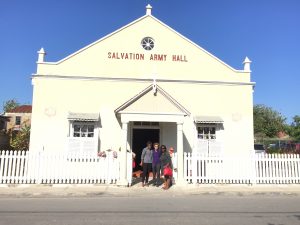
Even before we spoke, Shirley Duncan, a volunteer with Alzheimer’s Jamaica, and one of the event organizers, said, “I have a surprise for you.” She spoke eloquently of the need to talk about dementia, to share experiences, and to be there for the caregivers and people living with dementia. Then she told us that today’s participants were making a commitment to form an on-going group that would educate, advocate, and care for those affected by dementia in their community. “We are calling our group Debron, in honor of you two, because you are the catalysts,” she told us.
Ron had been working with Shirley and Dundeen Ferguson of Alzheimer’s Jamaica for several weeks, setting up the presentation. Shirley and Dahlia Klein orchestrated the details, spreading the word among the community leaders, garnering the venue, and making sure all went smoothly. We were thrilled to be catalysts and delighted to be discussing ideas with such a dedicated group of women, many of whom were former teachers.
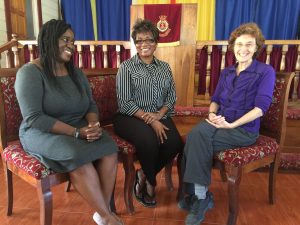 We shared ideas from Dr. Madan Kataria in Mumbai about the power of laughter yoga, and we told a story about creating an inland beach from, Dr. Claire Craig in Sheffield, England. We talked about the power of Dan Cohen’s Music & Memory program and discussed ways to connect through art, citing a story from Teri Miller in Houston, Texas. And we chatted about ways to stay connected through cooking together, sharing our own favorite childhood dishes, which included spiced shrimp, banana porridge, dumplings, roasted corn with shredded coconut, and so much more.
We shared ideas from Dr. Madan Kataria in Mumbai about the power of laughter yoga, and we told a story about creating an inland beach from, Dr. Claire Craig in Sheffield, England. We talked about the power of Dan Cohen’s Music & Memory program and discussed ways to connect through art, citing a story from Teri Miller in Houston, Texas. And we chatted about ways to stay connected through cooking together, sharing our own favorite childhood dishes, which included spiced shrimp, banana porridge, dumplings, roasted corn with shredded coconut, and so much more.
“We will spread these ideas throughout our community,” one of the women told us. “That is what teachers do, we share information.”
We left feeling so inspired and so connected. This is what we all need, caring people, compassionate and eager to learn, ready to offer help and hope.
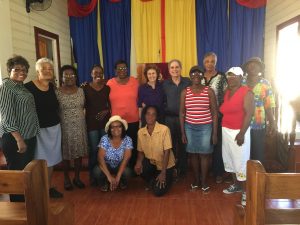
###
During our presentation, we talked about Dr. Madan Kataria’s Ha Ha chorus. At the end, the women said, “We want to sing you a song.” They serenaded us with the Ha Ha chorus. Watch this video and please, sing along.
https://drive.google.com/open?id=0B0elXRV1YrIqUkhqNzN3RkhPSUU
For more about Laughter Yoga, visit Madan Kataria’s website, http://laughteryoga.org
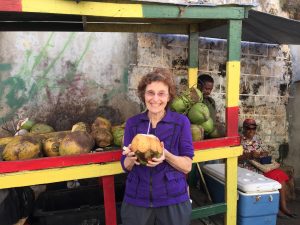
Deborah Shouse is the author of Connecting in the Land of Dementia: Creative Activities to Explore Together and Love in the Land of Dementia: Finding Hope in the Caregiver’s Journey.
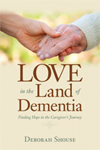

Tuning into Music for Connection: Helping Children Accept Dementia
“Oh what a beautiful morning,” I warbled. My mom clapped and hummed along. At the end of the song, she applauded. In her earlier days of motherhood, she might have winced slightly when I wandered off-key. But in the cradle of dementia, she was delighted with my smile, my energy, and the sheer sound of my voice. And I was delighted to be tuning into music for connection.
Carol Bradley Bursack, an author, speaker, family care partner and creator of Minding Our Elders, recently told me the story of how she helped her teenage children stay connected with their grandfather. I loved her ideas and wanted to share her tips with you.
Tuning into Music for Connection
When he was in his 70s, Carol’s father went into surgery to help repair brain damage from a World War II injury. The doctors expected no issues, but during the operation, something went awry. Her beloved father emerged from the procedure deep in dementia, with a constant voice in his head, and no grasp of reality. Valiantly, Carol dealt with her anger and grief while finding a safe and compassionate care community for her father. Then she began searching out ways she and her sons could stay connected with him.
“Dad loved big band music,” Carol says. “I bought every CD I could find. He loved to direct and listen to the music.”
Finding a Musical Bridge
Carol’s sons were very close to their grandfather. He had always been there for them, a vibrant, fun presence, celebrating their abilities, playing chess with them, and listening to their stories. When her sons saw that Grandfather was so changed he couldn’t even hug them and no longer understood the chessboard, they were devastated.
“They didn’t know how to bond with him,” Carol says.
Carol understood their reluctance to visit and gave them some space. She didn’t make the children feel guilty about their feelings, but she did want them to maintain a relationship with their grandfather. Tuning into music for connection came to the rescue.
The boys both played instruments and Carol urged them to take their clarinet and trumpet to the care community. At first, they were hesitant. They stood shyly before this new grandfather, barely able to blow out the notes. But at the end of their first short tune, Grandfather beamed and asked for an encore. The boys grinned and played more confidently. People came from down the hallways, wanting to hear the music.
“The boys and their music had made a connection,” Carol says. “All three of them were happy and relaxed.”
Creating Together to Build Connection
Carol continued to seek ways to help her sons feel comfortable during their visits. She also wanted them to feel a sense of accomplishment and to cherish their relationship with their grandfather.
Sometimes the boys took hand-drawn pictures to decorate the walls. Other times, they showed up with examples of science projects and told their grandpa about them. The boys brought chess pieces, old photos from Grandpa’s younger days, and games that they’d played with Grandpa. They invited their grandfather to share stories about these objects and often he did.
“It’s hard for young minds to accept such changes,” Carol says. “Their grief can slide under the radar. I was constantly looking for activities we could share, projects that were mutually engaging and that Grandpa could understand.”
Through it all, their mutual love of music kept them together.
For more information on the important work Carol is doing, visit her website: www.mindingourelders.com.
And treat yourself to her book, Minding Our Elders.
Deborah Shouse is the author of Connecting in the Land of Dementia: Creative Activities to Explore Together and Love in the Land of Dementia: Finding Hope in the Caregiver’s Journey.
Using Creativity to Live Successfully with Dementia
“Creativity is evident in every one of us,” says Michelle Niedens, Director of Education, Programs and Public Policy, Alzheimer’s Association Heart of America Chapter. Every time I hear Michelle talk about the creative aspects of living with dementia, I am moved. I was so honored to have Michelle speak at my book launch for Connecting in the Land of Dementia. I treasured what she said about using creativity to live successfully with dementia and I asked if she would allow me to share her words of wisdom and caring with you. Here is her beautiful talk.
Using Creativity to Live Successfully with Dementia
by Michelle Niedens
It has been said that “we are helped by what is not, to use what is”. In Alzheimer’s disease, there are some things that are not. But welcoming this philosophy of using what is allows us to explore all the parts that are. As part of projects focusing on creativity at the Alzheimer’s Association, I have heard many people talk about how they are not creative. In one way or another, they find a way to let me know they believe they cannot create art, or stories or a collage or whatever forms of creation lay before them. Yet if we allow our minds to really think about the place of creativity in our lives, we could make a case that it is evident in every one of us. Whether it be building book shelves, writing poetry, the way we frame our words in conversation, the way we problem solve, the way we play with children, the way we garden and even the way we convince ourselves of things. Life is both complicated and simple and requires creativity to survive. It is almost as ever present as thought and breath.
In the poem, “the Necessary Art of Salvaging”, Barbara Lau writes;
Adapting to Dementia: Laurie Scherrer’s Inspiring Story
“I’m having a slow day,” Laurie Scherrer says, when I call her Pennsylvania home for our scheduled conversation on adapting to dementia. “So bear with me.”
It was easy to bear with Laurie, as she is bright, positive, articulate, insightful, and authentic.
I met her during a telephone interview for the esteemed podcast, Alzheimer’s Speaks, which she co-hosted along with founder Lori La Bey. I was so impressed with both of the women’s insights and interviewing abilities, and I wanted to learn more about how Laurie managed her life with early onset dementia. Here are some highlights from our conversation.
From Sales Leader to Closet Cleaner
How do you go from excelling in a distinguished business career as a top manager and sales leader to becoming an unemployed 55-year-old woman who can no longer do a simple math problem or weed her prized garden?
That’s what happened when Laurie Scherrer was diagnosed with early onset dementia in 2013. After days of languishing at home, cleaning out closets, and feeling like a complete nobody, she realized she needed to take action. And being a woman filled with determination and creativity, she did just that, with her husband offering his unwavering support.
“I have a passion for excellence and the recognition that comes with it,” Laurie says. “Being Number One in sales drove me.”
Since she had nothing to push towards, she turned toward writing blogs and to her former passion for sewing, so she’d once again feel accomplished. Plus, Laurie wanted something tangible to give to her family members, something that said, “I love you.”
Forgetting the Curves and Going Straight
In her earlier days, before her career consumed much of her time, Laurie was an accomplished seamstress, reveling in creating costumes for church programs. She had loved sewing quilts and clothes and decided she’d return to her former hobby.
She sat down with yards of fabric, ready to cut quilting squares. But hard as she tried, she could not figure out how to cut the fabric. She was slumped over her sewing machine, weeping, when her neighbor dropped by.
“I can’t do this anymore,” Laurie said.
“I’ll help you,” her neighbor said.
She brought over a cutting board with lines in it and talked Laurie through the process of cutting the cloth.
“Once she helped me lay it out, I could do it again,” Laurie says. 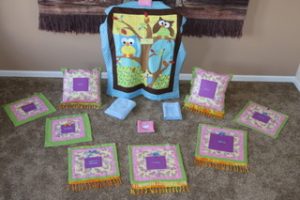
Laurie has since created blankets, pillowcases, burping cloths, and more for her family.
“The straight lines are working for me,” she says.
Noticing the Blessings
Laurie is making the most of her life. She treasures her glorious back yard and her deepened relationship with nature.
“Before, I was so busy, I never saw all the beauty around me,” she says.
She also treasures her worldwide friendships with people living with dementia, which she nourishes through video chatting and posting on Facebook. She and some chat friends recently started a virtual spiritual dementia café, where they read, discuss scripture and pray with and for people from all over the world.
Most of all she loves knowing she is giving back and helping others through her writing, speaking, radio hosting, and advocacy.
Teaming Up to Produce Great Results
Laurie and her husband work together to help her live a vibrant life. Here are their tips:
- Have a designated place and time to escape to, with no phones or email, so you can talk, cry, and really express yourself.
- Talk through the tough times. Notice when someone has a difficult day and figure out how you can improve things.
- Work together to adapt beloved activities.
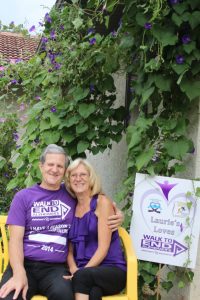
- Laugh as much as possible.
- Be thankful for every good moment.
I know you’re going to want to know more about this remarkable woman and her tips for adapting to dementia. Visit https://dementiadaze.com/about-me/
Deborah Shouse is the author of Connecting in the Land of Dementia: Creative Activities to Explore Together and Love in the Land of Dementia: Finding Hope in the Caregiver’s Journey.


Creating a Memorable Dementia-Friendly Movie Experience
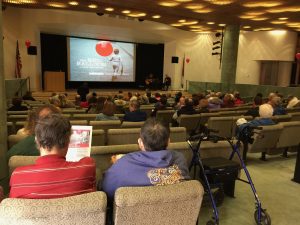 For months, our Kansas City Movies and Memory team has been working on creating a memorable dementia-friendly movie experience and film series. Ron and I were so lucky to partner with the Heart of America Chapter of the Alzheimer’s Association, the Kansas City Public Library, and the Kansas City FilmFest. For our first offering, we wanted a short movie with a splash of fun and a heart-filled message that would engage multi-generations. We wanted live music and free popcorn. We wanted each person to walk away with a souvenir. And we wanted to attract a diverse audience.
For months, our Kansas City Movies and Memory team has been working on creating a memorable dementia-friendly movie experience and film series. Ron and I were so lucky to partner with the Heart of America Chapter of the Alzheimer’s Association, the Kansas City Public Library, and the Kansas City FilmFest. For our first offering, we wanted a short movie with a splash of fun and a heart-filled message that would engage multi-generations. We wanted live music and free popcorn. We wanted each person to walk away with a souvenir. And we wanted to attract a diverse audience.
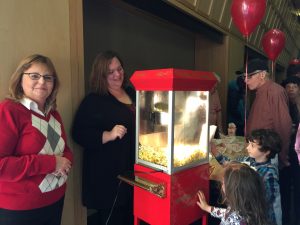 The Red Balloon was a wonderful success. This ageless film, about a boy and his magical balloon, attracted one hundred people, from ages three up through the nineties. Our audience, little kids and big kids both, clustered around the popcorn machine, watching the aromatic kernels blossom. They listened to Parisian songs by a renowned clarinetist and a guitarist. They learned a little about creating a “memory aware” city. And they laughed, smiled, sat on the edge of their seats, and clapped, all avidly involved in the movie. At the end, we walked out holding a huge bouquet of red balloons and each person was excited to take home a lovely reminder of the afternoon.
The Red Balloon was a wonderful success. This ageless film, about a boy and his magical balloon, attracted one hundred people, from ages three up through the nineties. Our audience, little kids and big kids both, clustered around the popcorn machine, watching the aromatic kernels blossom. They listened to Parisian songs by a renowned clarinetist and a guitarist. They learned a little about creating a “memory aware” city. And they laughed, smiled, sat on the edge of their seats, and clapped, all avidly involved in the movie. At the end, we walked out holding a huge bouquet of red balloons and each person was excited to take home a lovely reminder of the afternoon.
Here’s what we learned: when you’re taking photos of people holding balloons, you don’t even have to ask them to say, “Cheese.” They’re already smiling.
Here’s the great news.
You can easily have this movie experience at home. It’s perfect for an intergenerational family gathering, a holiday event, or just a cozy evening at home.
Here are a few tips for creating a memorable movie experience:
- Pick a time of day where everyone has good energy. Our event was held at 2:00 in the afternoon.
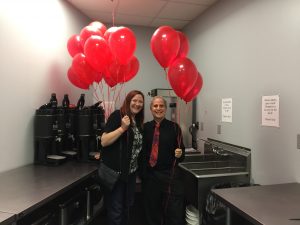
- Make sure the technology is organized and everyone can see the screen.
- Arrange for comfortable seating and minimal distractions.
- Offer your favorite movie-going indulgences. Freshly popped popcorn is irresistible.
- Talk about what you’re going to see.
- If you want, stop the movie in the middle and talk about what you’ve seen. Ask open-ended questions, such as “Would you have climbed the pole to fetch the balloon?” “Why do you think the boy loved the balloon so much?” “What does this movie make you think of?”
- At the end, talk about the movie: what you liked, what you didn’t like, and what the movie made you think about.
- When the movie experience is complete, hand each person a helium-filled red balloon. Even a red balloon filled with hot air will do!
The Red Balloon is just one idea. Please tell us about movies or TV shows you have enjoyed watching and share your film-watching tips.
Deborah Shouse is the author of Connecting in the Land of Dementia: Creative Activities to Explore Together and Love in the Land of Dementia: Finding Hope in the Caregiver’s Journey.